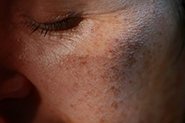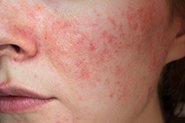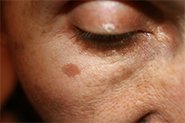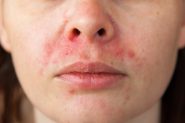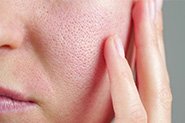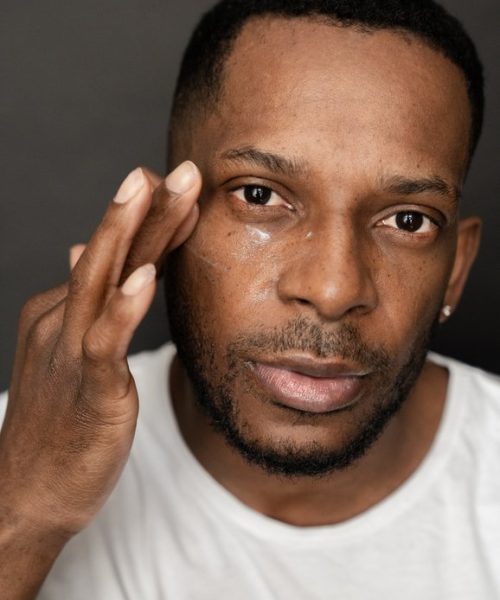
How to treat dark under-eye circles is one of our most-asked questions for all ages and skin types (essentially, we all have them!). But can a cosmetic eye cream fix them? Read on to find out the truth about eye creams and dark circles…
What causes dark undereye circles?
The problems with treating this common skin complaint start here: there are multiple different causes of dark circles, and sometimes more than one at the same time [1]:
- SHADOWING EFFECTS: some circles are caused by shadows being cast by either prominent blood vessels showing through thin undereye skin (this can be age-related and/or hereditary and typically results in blue/purple coloured shadows). Some shadows are caused by differences in the contour around the eye (the ‘periorbital contour’), such as loss of bone, movement in fat pads, muscle changes and sun damage. This type of shadowing can occur, or worsen, with age.
- EXCESSIVE HYPERPIGMENTATION: From a number of causes, such as asthma, allergies, eye rubbing, contact allergies (sometimes to eye creams!), periorbital dermatitis, and eczema.
- HEREDITARY HYPERPIGMENTATION: Genetics can play a big part in undereye circles, especially in skin of colour [2].
- OTHER CAUSES (LESS COMMON): Dark circles can be caused by some drugs (e.g. bimatoprost, some antibiotics, contraceptive pill), and can even occur during pregnancy.
What about lack of sleep? Doesn’t this cause dark circles?
If only it were as easy as getting a good night’s sleep to fix dark circles ! The bad news is that getting more sleep has no impact on the severity of dark circles when measured objectively (despite what your mother told you!) [2,3]
But, subjectively, poor sleep can make us feel that our dark circles are worse when we look in the mirror [3,4]
So what DOES work to fix dark circles [1,5]?
The first (and most important!) step is always a proper assessment to diagnose *your* underlying cause/s before developing an individual treatment plan – this is something that requires visual inspection, so it cannot be performed from a questionnaire and photos alone – another reason why video telehealth is the gold standard in online prescribing!
A treatment plan may involve one or more of the following, depending on the cause:
- Laser for vessels and collagen-building in thin skin
- Sorting out any allergies and/or periorbital dermatitis with a medical professional
- Surgery/fat transfer/VERY careful use of fillers for contour issues
- Depigmenting agents (Hydroquinone is the gold standard ingredient) for excessive hyperpigmentation (under close medical supervision)
- Retinoids to improve thin/sun damaged skin under the eye (again, under close medical supervision – this will not be suitable for everyone)
- Spending time and effort to find a really great concealer along with brightening cosmetics like colour correctors
What DOESN’T work (and you can save your money on):
- Cosmetic eye creams that claim to fix dark circles
- Getting more sleep
- Oh, and drinking water – this is the standard answer celebrities give when trying to deflect attention away from the real answer: ‘I have a cosmetic doctor on speed dial’
What a cosmetic eye cream can actually do:
Moisturise to help reduce fine lines by temporarily plumping the skin – so you’ll need to use it daily. But any moisturiser used around the orbital bone will have the same effect.
Do you know that perioral dermatitis is technically called ‘periorificial dermatitis’ because it can affect the eyes too? Learn more, CLICK HERE.
REFERENCES
- Friedmann DP, Goldman MP. 2015. Dark circles: etiology and management options. Clin Plast Surg. PMID: 25440739.
- Matsui MS, Schalka S, et al. 2015. Physiological and lifestyle factors contributing to risk and severity of peri-orbital dark circles in the Brazilian population. An Bras Dermatol. PMID: 26375218.
- Oyetakin-White P, et al. 2015. Does poor sleep quality affect skin ageing? Clin Exp Dermatol. PMID: 25266053.
- Lim HGY, Fischer AH, et al. 2021. Periocular Dark Circles: Correlates of Severity. Ann Dermatol. PMID: 34616119.
- Pissaridou MK, Ghanem A, Lowe N. 2020. Periorbital Discolouration Diagnosis and Treatment: Evidence-Based Review. J Cosmet Laser Ther. PMID: 34078228.
WOULD YOU LIKE TO CHAT TO ONE OF OUR FRIENDLY DOCTORS ABOUT YOUR SKIN?
CLICK HERE TO BOOK A CONSULT WITH OUR EXPERIENCED MEDICAL TEAM.


